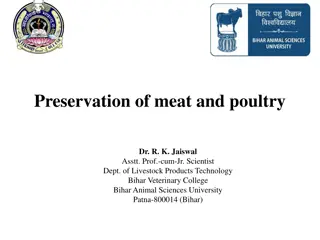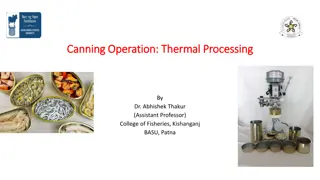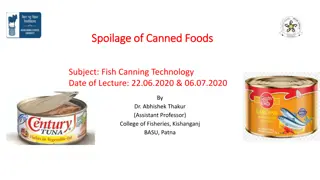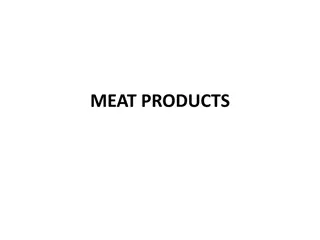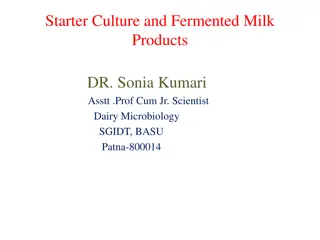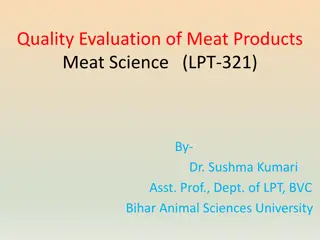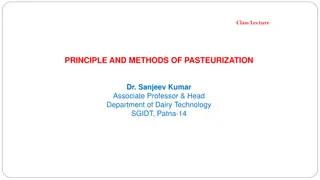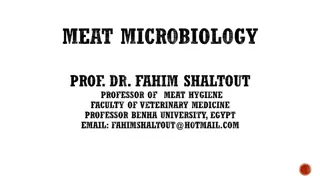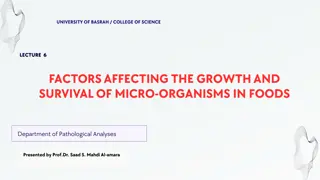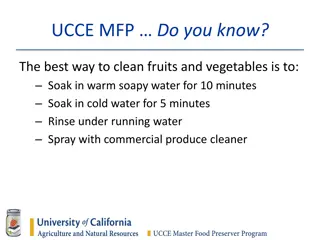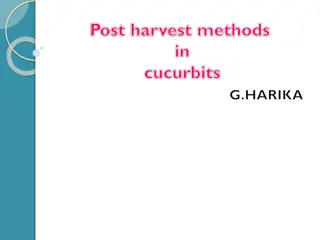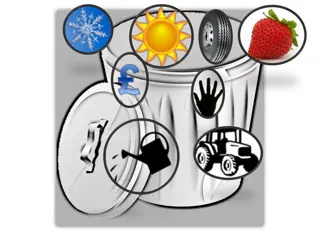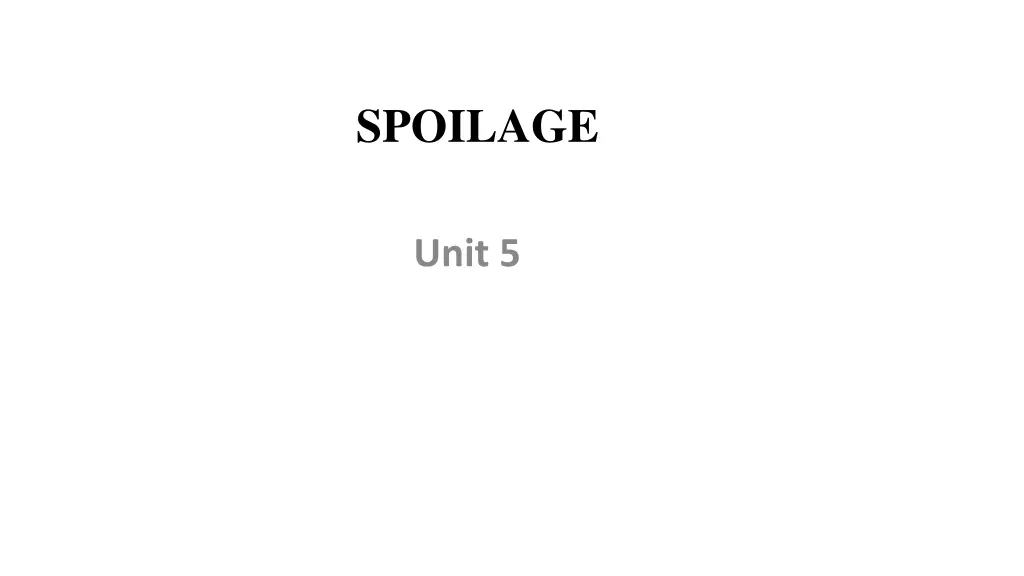
Understanding Pharmaceutical Spoilage and Contamination
Learn about the types of spoilage in pharmaceutical products, factors affecting microbial spoilage, sources of microbial contaminants, and the importance of preservation using antimicrobial agents. Discover how spoilage can impact product quality, effectiveness, and company reputation, and explore the various types of microbial spoilage including chemical, physicochemical, and biological spoilage.
Download Presentation

Please find below an Image/Link to download the presentation.
The content on the website is provided AS IS for your information and personal use only. It may not be sold, licensed, or shared on other websites without obtaining consent from the author. If you encounter any issues during the download, it is possible that the publisher has removed the file from their server.
You are allowed to download the files provided on this website for personal or commercial use, subject to the condition that they are used lawfully. All files are the property of their respective owners.
The content on the website is provided AS IS for your information and personal use only. It may not be sold, licensed, or shared on other websites without obtaining consent from the author.
E N D
Presentation Transcript
SPOILAGE Unit 5
Contents Types of spoilage Factors affecting the microbial spoilage Sources and Types of Microbial contaminants Preservation of pharmaceutical products using antimicrobial agents Assessment/Evaluation of microbial contamination and spoilage
Spoilage Spoilage is defined as the chemical and physical degradation of pharmaceutical products rendering it unsuitable for use Spoilage is not desirable in the pharmaceutical industry because deterioration of drugs and Excipient occurs, as a result product may lose its quality and it may become ineffective. This may cause huge lose to the manufacturer. Moreover it may attract litigation from the consumers which may cause huge financial loss to the Company. Damaged products may damage reputation of the manufacturing company which may attract further financial loss. Microbes may deteriorate drugs and thereby reduce potency of the medicament.
Types of microbial spoilage Chemical spoilage Physicochemical spoilage Biological spoilage
Chemical spoilage Chemical spoilage is the deterioration of chemical nature of drugs and Excipients and also the molecular structure of ingredients may change which in turn may affect the physicochemical properties of the preparation Potency of the drug may decrease and further microbial growth may occur if the chemical degradation of Preservative occurs Along with microbial contamination some chemicals may also cause chemical spoilage like pesticide, disinfectants, bleaching agent, sanitizer etc. may add to chemical spoilage.
Physicochemical spoilage This type of spoilage may change physico-chemical properties of product. Following types of changes may occur. Gas production -Some microbes may produce gas inside the containers. These gases may be visible in the form of bubbles, floccules etc. Contamination of products with bacteria like E. coli may produce gas if it contains sugars. Colouration / Decolouration -Some microbes may decolourise formulation or it may produce unique colour which is different from the normal colour of the product.
Odour formation- Microbial growth in the finished product may produce bad odour or characteristic odour. It may produce a characteristic rotten smell. Taste change -Microbial spoilage may change the taste of the oral formulations. It may impart bitter or obnoxious taste to the oral formulation.
Biological spoilage Spoilage of pharmaceuticals may produce some undesirable and dangerous molecule which has undesirable biological effects. Some microbes may produce toxins, pyrogens or other harmful metabolites. These biomolecules may be present in the product from the very beginning. Spoilage may occur, although no microbial contamination was there. Some bacterial cells contaminate the pharmaceutical products and utilize the various compounds present in that formulation to perform their metabolic activities. Because of these metabolic activities, the microbial cells produce certain chemicals which they release in the pharmaceutical preparation. This is called Biological spoilage. Mainly two types of chemicals release by m.o.:- 1. Microbial toxins 2. Microbial metabolites.
Factors affecting the microbial spoilage There are many factors which affects microbial spoilage. Some of these factors reduce rate of spoilage where as some factors increases the rate of spoilage. They are Type of micro organism presence of nutrients presence of water oxidation reduction potential temperature ph containers and packing
Type of microorganisms -Some microorganisms are more aggressive than others. They can quickly multiply and spoilage is much faster. However, aggressive microbes may not multiply initially due to presence of preservative and other substances. Presence of nutrients In many products, Micro-organism can utilise formulation components as nutrients and utilise these components for biosynthesis and growth. Many formulations may contain crude animal, vegetable and microbial products which creates a conductive environment for microbial growth and subsequent spoilage. Additives like sugar, polyhydric alcohol may act as microbial nutrients. Primary contaminants may produce metabolites Which could be used by aggressive microbes as nutrient.
Preservatives used in pharmaceutical formulations Formulations Tablet methyl paraben, phenol Eye drops benzalkonium chloride Liquids or mixtures alcohol, methyl paraben Semi solids chlorocresol preservatives 1. 2. 3. 4.
Presence of water - Presence of water in formulation may promote microbial growth and subsequent spoilage. Uncomplexed water or free excess water promotes this spoilage. Presence of free water may be measured by water activity. It is a ratio between 'vapour pressure of formulation and vapour pressure of water in similar condition . If water activity is 1 then it is conductive for microbial growth. Chances of microbial growth decreases with decrease in value of water activity. A value less than 0.88 is considered safe to prevent spoilage
Temperature -Storage temperature is a great controller of microbial growth and spoilage. However, spoilage may occur over a range -20oC to 60oC. Microbial growth and spoilage is less in low temperature and high temperature. Storing products at a cool place (8oC to 12oC) may cause negligable spoilage . High temperature can also prevent spoilage.
pH- Microbes prefer neutral pH for their growth. However some microbes may prefer slightly acidic pH. Extremely acidic or alkaline pH of the formulation may prevent microbial growth and subsequent spoilage. Some communities of microbes can survive in extreme pH and change the pH, there by support growth of other micro-organism. Presence of protection materials - Some materials in formulation may protect microbes during sterilisation process. Polymers like gelatin, starch ete may increase microbial resistance to heat. Microbes may get adsorbed in particles and become more resistant to heat.
Containers and packaging - Chances of contamination in single dose ampoules and vials are negligible. However multidose containers be contaminated by users themselves. Change in designs of these containers may minimize contamination and spoilage. Containers are sealed such a way so that it can prevent entry of water and oxygen to minimize water activity and redox potential.
Sources and Types of Microbial contaminants In large scale, medium and small scale manufacturing contaminants can occur from the following sources 1. Water 2. Raw materials 3. Air in manufacturing area 4. Personnel 5. Equipments 6. Containers 7. Human Source 8. In hospital manufacturing
Water -Water is a major source of contamination. Common water borne micro-organism like Pseudomonas, Achromo bacteria and other low demand gram negative groups are present in portable water as well as in purified water. Ion-exchange column may be contaminated by water source and micro-organism may multiply there to contaminate purified water. Raw materials - Pharmaceutical products are prepared from varieties of raw materials. Claysand earth materials like bentonite, kaolin ete may contain anaerobia spores like Clostridium sp. Starch may contain coliform bacteria like E. Coli. Gums may contain actinomycetes. Animal Products may contain a variety of bacteria like E. coli, Salmonella sp ete.
Air is filled with billions of suspending particles and microbes. Fungus spores, like penicillium, aspergillus etc.( Bacterial spores like Bacillius sp. etc are also present.) These spores and micro-organism may contaminate pharmaceutical products. This type of contamination is minimized by practice of manufacturing in clean room and in aseptic room under continuous flow of sterile air through HEPA filter. Equipments -Equipments of manufacturing may contain microbes if it is not sterilised properly. Blender, filter may contain non-specific and local communities of micro-organism.
Personnel- manufacturing staff may also contaminate pharmaceutical products. Personnel may be infected with various types of infections like coliform bacteria, staphylococci, strepto cocci, Actino bacteria, Candida. This types of contamination may be minimised by proper health check-up, vaccination and hygiene of the personnel. Protective gear and proper training of the personnel may also minimize the contamination. Containers: containers may cause contamination if it is not sterile.
In hospital manufacturing In hospital manufacturing water and environment are the major source of contaminants. In hospitals, water is stored in storage tank which may develop fungus, bacteria and algae type of microbes. Hospital air may be contaminated with pathogenic micro-organism due to the presences of infected patients and numerous visitors. Human source- Pharmaceutical products may be contaminated during use. Patient may self contaminate his medicine. Contaminants may travel to other patients through doctors, nurses.
Preservation of pharmaceutical products using antimicrobial agents: Antimicrobial agents are those substances which can kill of inhibit growth of micro-organism. These antimicrobial agents are included in formulation in order to minimise levels of contaminated micro-organism. These antimicrobial agents are called preservatives. Preservatives are not used in those formulations which has low risk of contamination and subsequent microbial growth. Formulations which contains high level of acid, alkali, sugar etc may not require preservative. Formulations of antibiotics and other anti-microbial substances may not require preservative.
A good preservative should have following characteristics. 1. It should be a broad spectrum antimicrobial agent, i.e. it should be effective against variety of microorganisms. 2. A good preservative should have a fast killing and inhibition rate 3. A good preservative should be non-irritant and non-toxic to the patients. 4. A good preservative should be stable and it should remain active throughout the shelf-life of the product. 5. It has to be cost effective. 6. It has to be effective at low concentration.
Preservatives used in pharmaceutical formulations Formulations Tablet methyl paraben, Propyl paraben Eye drops benzalkonium chloride Liquids or mixtures alcohol, methyl paraben Semi solids chlorocresol preservatives 1. 2. 3. 4.
Concentration of preservatives determine efficacy of its preservation power. Antimicrobial activity of preservative increases with the concentration. Antimicrobial activity of preservative is also dependent on storage temperature. Decrease in storage temperature may reduce killing activity of preservative. Eg: Some mercuric compounds, such as thiomersal etc are used as preservative. Many other compounds like benzalkonium chloride, cetrimide are used as preservative. Even compounds like chloroform and formaldehyde can be used as preservative.
Assessment of microbial contamination and spoilage Assessment of microbial content of a pharmaceutical product is very essential. Sterile product should be perfectly free from micro-organism and that can be assessed by a test of sterility. However, non-sterile products may contain some micro-organisms. These micro-organisms could be pathogenic and non-pathogenic. All these micro-organisms can cause spoilage and may cause potential health hazard Total number of microbes and types of microbes is assessed by microbial limit test. Following tests are performed to assess the microbial contamination and subsequent spoilage.
Test for sterility Indian pharmacopoeia, British pharmacopoeia and United States pharmacopoeia recommends test of sterility for some pharmaceutical products.. Two methods are there i.e. Direct innoculation and membrane filtration. i) Direct inoculation- In this method, little amount of sample is directly added to the culture media which was specified in pharmacopeia. This inoculated media is then incubated for specified period of time. Presence of growth indicates the presence of micro organism which is sourced from sample. Hence it may be concluded that sample is not sterile. Sample may be termed sterile in absence of any growth.
Membrane filtration- In this method sample is filtered through a membrane filter and washed with diluting fluid. Microbes, if present, will be there at the top of the filter paper. Now this filter paper is inoculated into specified culture media. If growth is observed then it indicates that product is not sterile.
Microbial limit test It has two parts,(i) Total Aerobic microbial count and (ii) Test for specified microorganism i) Total Aerobic microbial count- In this method specified amount of test sample (10gm) is taken and mixed with specified amount (90ml) of peptone water. This is sample dilution. There are specific procedure to make dilutions for water insoluble products and fatty products. Total microbial count is examined by following procedure
First, examination of sample by membrane filtration method- 1. 10 ml of prepared dilution is mixed with 90 ml of peptone water and filtered through membrane filter. 2. It is then washed 3 times with sterile peptone water. One filter paper is placed in petridis containing Soyabean Caesin Digest Agar media and incubated for 5 days at 30- 35oC. 3. Bacterial count is determined by counting colonies. 4. Another filter paper is placed in Sabouraud Dextrose Agar Media and incubated for 5 days at 20-25oC. Fungal count is then determined
Second, Examination of sample plate count method- 1. In this method prepared dilution is directly transferred to 4 petridishes. Two for bacteria and two for fungus. 2. In first two petridishes 15 ml of Soyabean Caesin Digest Agar media is added. 3. Colonies are counter after incubationfor 5 days at 30- 35oC. 4. In remaining two petridishes 15 ml of Sabouraud Dextrose Agar Media was transfered and incubated at 20-25oC. 5. Colonies are counted.
(ii) Test for specified micro-organism- 1. Specific identification tests for Escherichia coli, Salmonella, Pseudomonas aeruginea and Staphylococcus aureus is performed 2. E. Coli is cultivated in Mac Conkes agar media. Colonies are identified by characteristics metalic shine. 3. Salmonella are cultivated on bismuth sulphite agar media and identified by black or green colonies. 4. Pseudomonas aeruginosa is identified by cultivating in cetrimide agar media. Colonies slow greenish colour. 5. Staphylococcus aureus is caltivated in Vogel Johnson agar media and identified by black colonies surround by yellow zones.
Periodic test Periodic test of the product for total microbial count must be done in order to determine continuing efficacy of the product.Many alternative tests may be done for detection and determination of micro-organism e.g Luciferase test, Epifluorescence, electrical impedance etc.
Evaluation of microbial stability of formulation This test is applied to the formulated medicines in its final container to determine whether it is protected against microbial spoilage It is used to check stability of multiple dose such as parenteral, oral, nasal , topical and opthalmic products made with aqueous bases or vehicles It is used to check the effectiveness of antimicrobial preservative These pharmaceutical formulation also evaluated at time to time
The test and standard apply only to the product in the original, unopened container, in which it is supplied by manufacturer Medium used for the initial cultivation of test micro- organism use soyabean casein digest agar medium Choice of test micro-organism and innoculum preparation The intention is to use micro-organism which are likely to arise in the raw material used in the product and which occurs in the manufacturing environment and represent a particular health hazard, if they grow in the product
The test micro-organism used for preservative efficacy 1. Staphylococcus aureus ATCC 6538 2. Pseudomonas aeruginosa ATCC 9027 3. E.coli ATCC 8739 4. Candida albicans ATCC 5. Aspergillus brasiliensis ATCC 16404 Fresh stock culture of each test micro-organism is subcultured on the surface of soyabean casein digest agar medium Incubate the bacterial culture at 30-35 C for 18-24 hrs
Using sterile saline solution harvest the bacteria and dilute Suitably with sterile saline solution to bring the count to about 1 10 cfu/ ml Procedure 1. Inoculate each original product container with one of the standardized microbial suspension using a ratio equivalent to 20ml of product and mix 2. Final concentration should be 1 10 1 10 microbes per ml of products 3. Determine the number of viable micro-organism by the plate count method and calculated the initial concentration of microbes per ml
1. Incubate the inoculated container or tubes at room temperature 2. Determine the viable count by the plate count method at 7,14 and 28 day subsequent to inoculation 3. Calculate the percentage of reduction in cfu per ml for each organism at the states test intervals and express the change in terms of percentage of initial concentration
Interpretation of results For parenteral, opthalmic, sterile nasal and otic preparations The concentration of viable bacteria is not more than 10% of initial concentration at 7 days and not more than 0.1% of initial concentration at 14 days and there is further decrease in count at 28 days For topical preparations The concentration of viable bacteria is not more than 1% of initial concentration at 14 days and there is further decrease in count at 28 days
For oral preparations Not more than 10% of initial concentration at 14 days and further decreases





